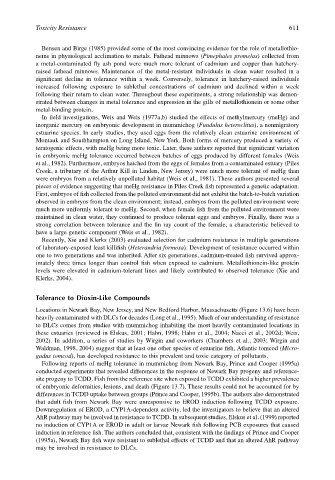Page 631 - The Toxicology of Fishes
P. 631
Toxicity Resistance 611
Bensen and Birge (1985) provided some of the most convincing evidence for the role of metallothio-
neins in physiological acclimation to metals. Fathead minnows (Pimephales promelas) collected from
a metal-contaminated fly ash pond were much more tolerant of cadmium and copper than hatchery-
raised fathead minnows. Maintenance of the metal-resistant individuals in clean water resulted in a
significant decline in tolerance within a week. Conversely, tolerance in hatchery-raised individuals
increased following exposure to sublethal concentrations of cadmium and declined within a week
following their return to clean water. Throughout these experiments, a strong relationship was demon-
strated between changes in metal tolerance and expression in the gills of metallothionein or some other
metal-binding protein.
In field investigations, Weis and Weis (1977a,b) studied the effects of methylmercury (meHg) and
inorganic mercury on embryonic development in mummichog (Fundulus heteroclitus), a nonmigratory
estuarine species. In early studies, they used eggs from the relatively clean estuarine environment of
Montauk and Southhampton on Long Island, New York. Both forms of mercury produced a variety of
teratogenic effects, with meHg being more toxic. Later, these authors reported that significant variation
in embryonic meHg tolerance occurred between batches of eggs produced by different females (Weis
et al., 1982). Furthermore, embryos hatched from the eggs of females from a contaminated estuary (Piles
Creek, a tributary of the Arthur Kill in Linden, New Jersey) were much more tolerant of meHg than
were embryos from a relatively unpolluted habitat (Weis et al., 1981). These authors presented several
pieces of evidence suggesting that meHg resistance in Piles Creek fish represented a genetic adaptation.
First, embryos of fish collected from the polluted environment did not exhibit the batch-to-batch variation
observed in embryos from the clean environment; instead, embryos from the polluted environment were
much more uniformly tolerant to meHg. Second, when female fish from the polluted environment were
maintained in clean water, they continued to produce tolerant eggs and embryos. Finally, there was a
strong correlation between tolerance and the fin ray count of the female, a characteristic believed to
have a large genetic component (Weis et al., 1982).
Recently, Xie and Klerks (2003) evaluated selection for cadmium resistance in multiple generations
of laboratory-exposed least killifish (Heterandria formosa). Development of resistance occurred within
one to two generations and was inherited. After six generations, cadmium-treated fish survived approx-
imately three times longer than control fish when exposed to cadmium. Metallothionein-like protein
levels were elevated in cadmium-tolerant lines and likely contributed to observed tolerance (Xie and
Klerks, 2004).
Tolerance to Dioxin-Like Compounds
Locations in Newark Bay, New Jersey, and New Bedford Harbor, Massachusetts (Figure 13.6) have been
heavily contaminated with DLCs for decades (Long et al., 1995). Much of our understanding of resistance
to DLCs comes from studies with mummichog inhabiting the most heavily contaminated locations in
these estuaries (reviewed in Elskus, 2001; Hahn, 1998; Hahn et al., 2004; Nacci et al., 2002d; Weis,
2002). In addition, a series of studies by Wirgin and coworkers (Chambers et al., 2003; Wirgin and
Waldman, 1998, 2004) suggest that at least one other species of estuarine fish, Atlantic tomcod (Micro-
gadus tomcod), has developed resistance to this prevalent and toxic category of pollutants.
Following reports of meHg tolerance in mummichog from Newark Bay, Prince and Cooper (1995a)
conducted experiments that revealed differences in the response of Newark Bay progeny and reference-
site progeny to TCDD. Fish from the reference site when exposed to TCDD exhibited a higher prevalence
of embryonic deformities, lesions, and death (Figure 13.7). These results could not be accounted for by
differences in TCDD uptake between groups (Prince and Cooper, 1995b). The authors also demonstrated
that adult fish from Newark Bay were unresponsive to EROD induction following TCDD exposure.
Downregulation of EROD, a CYP1A-dependent activity, led the investigators to believe that an altered
AhR pathway may be involved in resistance to TCDD. In subsequent studies, Elskus et al. (1999) reported
no induction of CYP1A or EROD in adult or larvae Newark fish following PCB exposures that caused
induction in reference fish. The authors concluded that, consistent with the findings of Prince and Cooper
(1995a), Newark Bay fish were resistant to sublethal effects of TCDD and that an altered AhR pathway
may be involved in resistance to DLCs.

